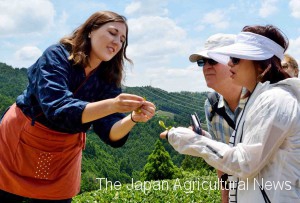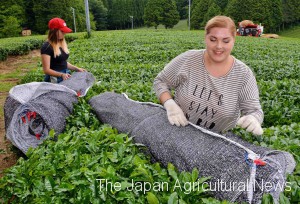KYOTO and Nara, June 29 — Given the growing overseas popularity of Japanese tea, the number of international participants of internship programs at Japanese tea nurseries is increasing in number. Some tea gardens are so popular that it receives ten times as many applications as it has places. Many of the programs are the courses of three months or shorter that require no visa. For the trainees, the knowledge and experience gained in Japan will hopefully help them get jobs as instructors or managers of tea specialty shops back home. For tea growers, the trainees are not just new workers but people who can help them communicate the pure beauty of Japanese tea to the world.
“I want to convey the real taste of Japanese tea,” Naoki Okunaka, the 45-year-old president of Yamato-en in Yamazoe village, Nara Prefecture, answered to a question asking why he began having foreign trainees at his tea garden.
Some years ago, during his visit abroad for Japanese tea promotion, he was shocked to see people adding milk, sugar, flower or fruits flavors to matcha, powdered green tea. “Our times and efforts involved in growing high-quality tea leaves had been wasted. Then I thought I must develop international tea specialists,” he said. Okunaka put an ad on a website to invite people to join the training which started in September last year.
Japanese green tea production usually involves a steaming process to seal in its fresh color and flavor. Unfortunately, the global green tea market is currently dominated by the tea leaves made in China with some additional flavors.
Yamato-en tea garden so far has trained a total of five learners from France, the Netherlands, and the Switzerland. They spend a lot of time in the nursery, carrying tea leaves to the plant and rolling up covering clothes, and communicate with the employees of the company basically by gestures. They are served free cups of tea during their field works.
For Sarah Gauthier, a 21-year-old French graduate student, the three-month stay in Japan provided her the opportunity to learn, in surprise, what is the real taste of Japanese tea. “I become intrigued by the way how Japanese tea manufacturers pay attention to the quality of their products. I want to get a job that involves Japanese food,” she said with sparkling eyes.

A trainee from the U.S. (left) helping tea plantation tours as a guide for overseas travelers (in Wazuka town, Kyoto)
A tea nursery in Wazuka town, Kyoto, is also attracting those who want to become Japanese tea specialists. When the tea plantation, Obubu-Chaen, decided to offer a course for four persons, it received applications from 40 candidates. The course began in 2012, and so far the company has trained 70 people from approximately 20 countries, mainly from Europe and the U.S. Many of them are hoping to take advantages of this unique experience to get better jobs. For three month, they learn how Japanese tea leaves are produced and sold, and help the tea company host overseas travelers.
A German university student, Pascal Teitscheid, 21, participated in the internship program before he takes over his family business to run a tea specialty shop back home. Having tea around him always from early childhood, he had confidence in his knowledge about tea. However, he said, “I want to talk to my customers based on my own experience. Now I’ve learned the entire process of tea production, from growing tea leaves to making a nice cup of tea. I treasure this experience for life.”
The trainees are already helping the tea grower make more profit as they sell tea leaves in the U.S., the U.K., Germany, and Spain. In 2012, exports accounted for 3% of the entire sales of the tea seller, but in 2016, the ratio boosted to 20%, more than sixfold in only four years. “We want to make this place one of the must-go locations for international learners of Japanese tea and expand this system to all over Japan,” Yasuharu Matsumoto, deputy president of Obubu-Chaen said.


